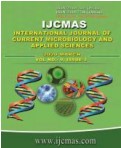


 National Academy of Agricultural Sciences (NAAS)
National Academy of Agricultural Sciences (NAAS)

|
PRINT ISSN : 2319-7692
Online ISSN : 2319-7706 Issues : 12 per year Publisher : Excellent Publishers Email : editorijcmas@gmail.com / submit@ijcmas.com Editor-in-chief: Dr.M.Prakash Index Copernicus ICV 2018: 95.39 NAAS RATING 2020: 5.38 |
The present research work was carried out to study the effect of concentrate feeding on body weight and benefit cost ratio of weaned kids of Sirohi goat. Twenty four kids of Sirohi breed between 3-4 months age were randomly selected on the basis of uniform body weight, age and divided into 3 groups of 8 kids each at the goat farm of S.K.N. College of Agriculture, Jobner. Group T1 served as control supplemented with 50 g concentrate per kid per day for 3 months. Group T2 (treatment) supplemented with 50, 100 and 150 g concentrate and T3 (treatment) with 100, 150 and 200 g concentrate per head per day for 1st, 2nd and 3rd month, respectively. Other management practices were similar for each group. Fodder of khejri loom was offered ad-libitum to all groups. Body weight of kids was recorded weekly. Group T3 fed with more quantity of concentrate achieved the highest (85.77 g/day) average weekly weight gain followed by T2 (69.22 g/day) and control group T1 (61.33 g/day). Maximum average total weight gain per kid was observed in group T3 (7.72 kg) followed by T2 (6.23 kg) and least was found in T1 (5.52 kg). It is concluded from the results that there was significant increase in weekly and monthly weight gain (P≤0.01) of kids supplemented with higher quantity of concentrate in diet. Thus from above findings it can be concluded that T2 and T3 treatments showed significantly improved body weight in Sirohi kids and higher level (T3) was relatively the best level in terms of both biological and economical returns.
 |
 |
 |
 |
 |